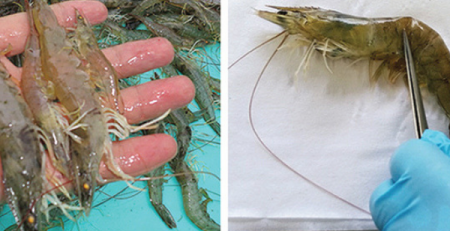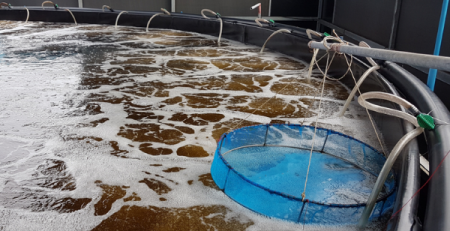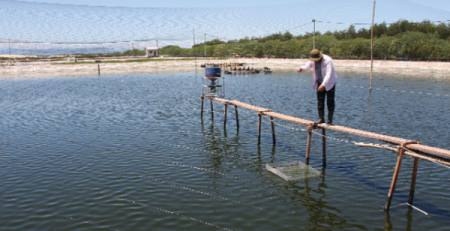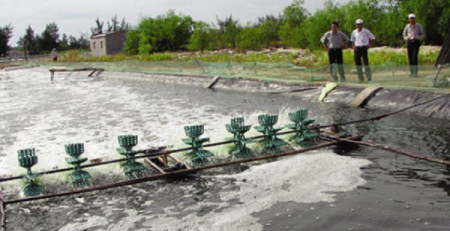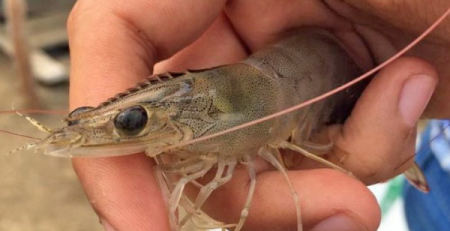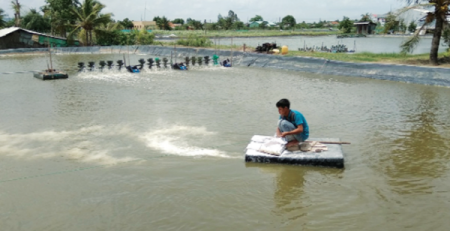Treatment of white feces disease for shrimp

Signs of shrimp white feces disease
In the hot season, high water temperature, high density, pond improvement does not meet the technical requirements, which are factors that make white faecal diseases spread quickly, reducing productivity, causing serious damage to people.
Nội dung bài viết
Reason
White manure is a common disease in farmed shrimps that usually start from the time of shrimp farming 40 days onwards; Many agents can cause disease. Initially, there may be only one specific factor causing the disease first, then other factors have the opportunity to attack again when shrimp have weakened antibody ability. Because the cause of the disease is sometimes not only because of an agent, the treatment is really effective only if we determine the right cause. The disease usually occurs when the temperature is> 32oC, dissolved oxygen <3 ppm; High concentrations of organic substances> 100 ppm; High concentrations of Vibrio> 1 x 102 CFU / ml; Alkalinity <80 ppm and> 200 ppm. Also due to the following agents:
• Food: Shrimp eat poor quality food or mold, toxins that lead to intestinal disease, white feces disease … The disease will become more serious in ponds with excess food;
• Toxic algae: Shrimp eat toxic algae such as cyanobacteria, thyroid algae … in the intestine, these algae secrete enzymes that can cause epithelial paralysis, causing intestinal shrimp to not absorb food and not digest Yes, leading to obstructed intestinal condition causing white feces disease in shrimp;
• Due to the Gregarine parasite: Gregarine primitive group, intermediate parasites on the mollusca group of two shells and the group of silkworms invading shrimp when they ingest intermediate hosts, which will cling to the intestinal wall of the shrimp, causing Intestinal lesions lead to white feces;
Symptom
The severely infected shrimps will become darker, seriously affecting the liver and intestinal tract, which will turn white. With specific expressions as follows:
– Appearance of white shrimp faeces on the surface or floating on the water surface, along pond banks, pond corners, end of wind direction;
– Shrimp are weak to eat (or stop eating if they are seriously ill), shrimp feces float to the surface and concentrate at the end of the wind direction. When observing the intestinal prawn, the food or food drum is broken;
– Examination by histological method of shrimp samples with white feces disease also found liver damage, liver cells die each peeling point;
– Severe inflammatory intestinal system does not absorb food, white shrimp feces, shrimp meat is not full of shells, soft shells;
– White fecal disease if detected early and treated promptly, shrimp’s ability to catch prey will return to normal; otherwise the intensity of giving up is increasing. Shrimp disease is on the rise, to some extent will see the phenomenon of dead shrimp scattered in the pond bottom, from a few to hundreds of children / day and every day is increasing.
Treatment
Stop feeding completely within 1-2 days;
Running the oxygen booster fan as much as possible helps to quickly disintegrate waste in the pond;
Replace clean water that has been treated 30 – 50% (Note to replace slowly to avoid shocking shrimp);
Find suitable solutions to reduce the concentration of organic substances in the pond (if the pond is regularly used, the substance will be deposited and then clean and clean. If the pond is not allowed to clot before, only microorganisms will be used) , do not disturb the pond bottom, causing H2S to diffuse into the water causing death of shrimp;
Use microorganisms at doses 3 times higher than normal doses of water and pond bottom treatment;
Mix the digestive microorganisms and garlic (10 g / kg) into the feed to feed the shrimp (do not mix garlic and microorganisms because garlic can inactivate micro-organisms);
Synchronize the above solutions within 5 consecutive days.
Prevention
Ponds need to be carefully prepared before stocking. For soil ponds, all residues and sludge must be completely removed. Water supplied to ponds should be treated with chemicals to remove pathogenic bacteria.
Control Vibrio in the pond by always maintaining low concentrations of organic substances such as: Managing the right amount of food and following the water temperature, siphon removing waste, maintaining algae density, using microorganisms decomposing organic matter of pond bottom and water.
Feeding the food according to the water temperature: When the water temperature rises> 32oC, shrimp often eat more but the time of feed passing through the digestive system is very short, increasing the amount of waste in the pond. High temperatures also make bacteria grow faster. Therefore, when the water temperature rises, do not increase the amount of food according to normal check.
Choose foods that are specialized for shrimp, quality feed, full of nutrients. Feed shrimp the right size for each culture period, with the right amount of feed and no excess. Food must be well preserved, free from mold and toxins.
Adequate supplement of shrimp health enhancers such as vitamins, probiotics and essential minerals. Good control of toxic algae and alkalinity in ponds.
Always maintain the beneficial microbial balance in the pond by regularly adding microorganisms and maintaining the lowest oxygen content of 3.5 – 4 ppm.
Source: Collector


